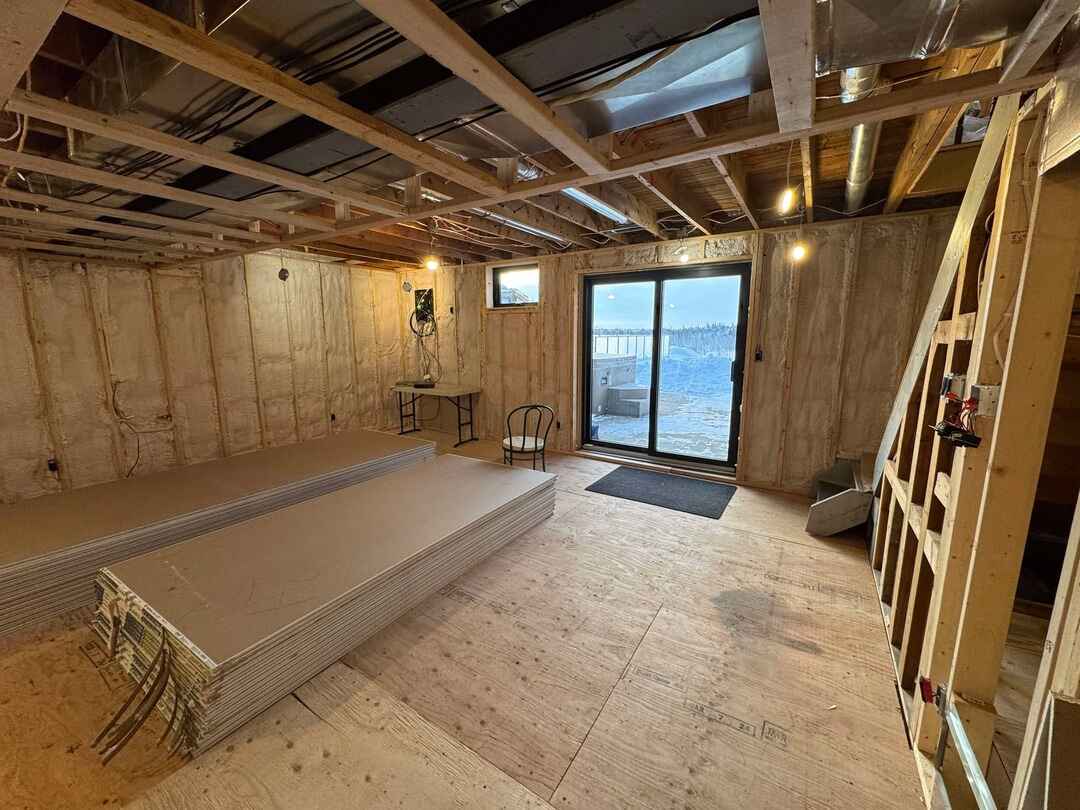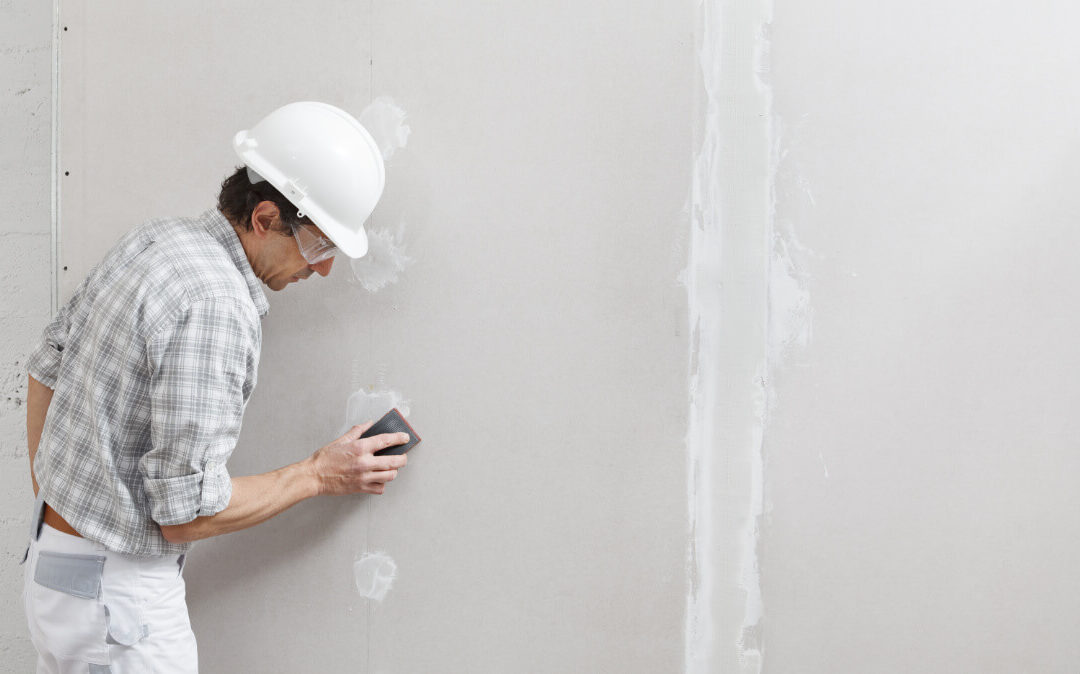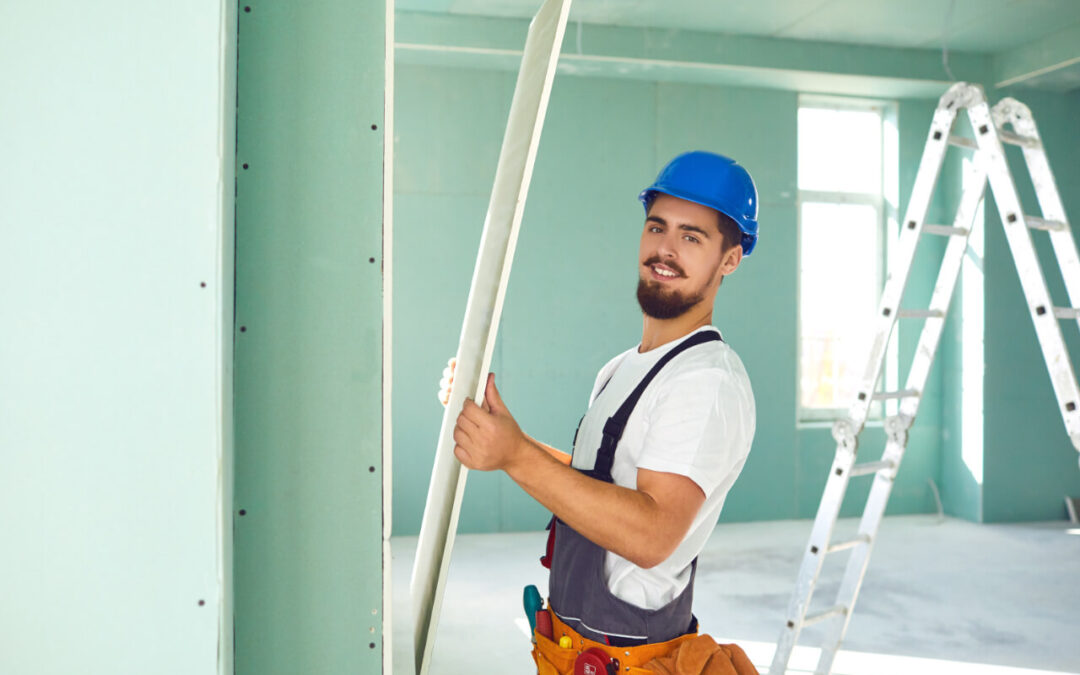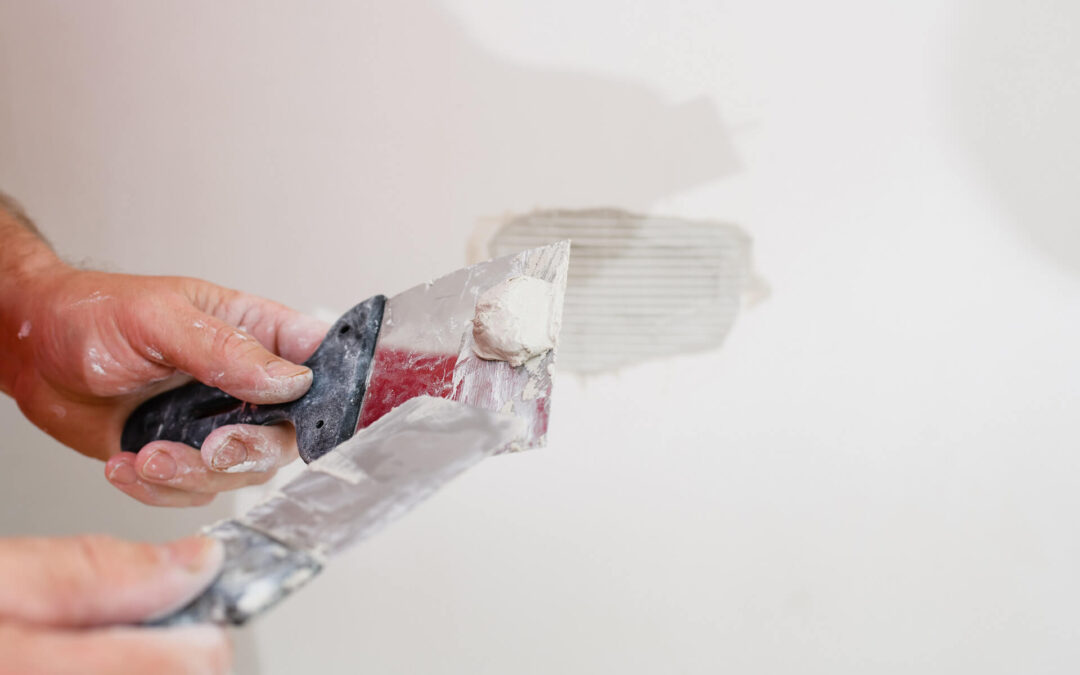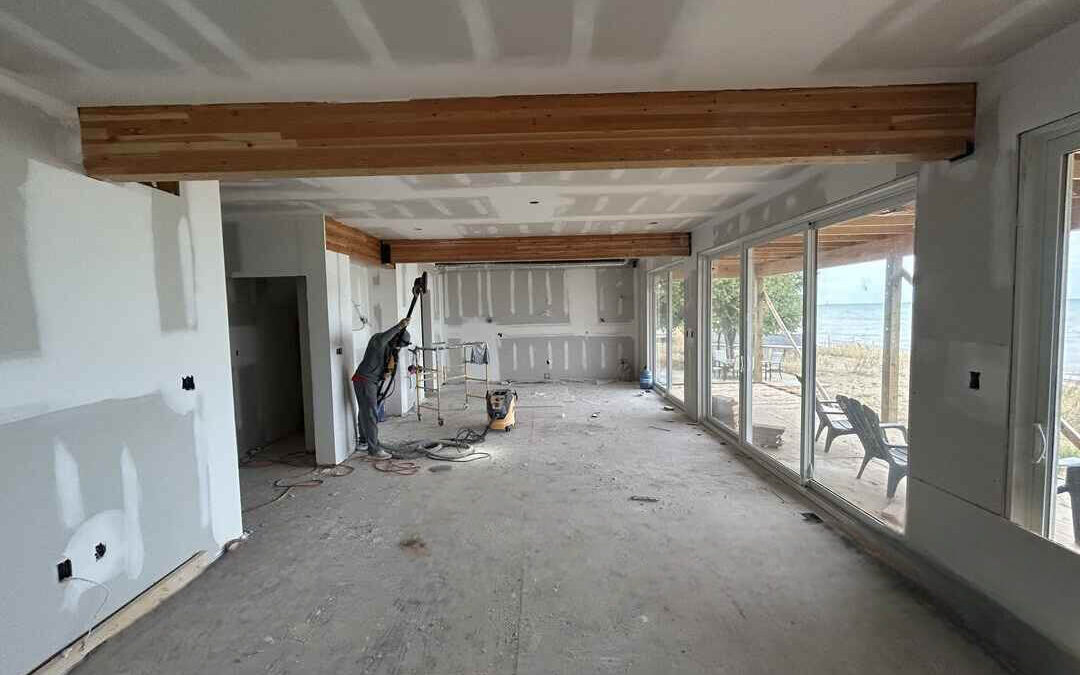Tired of chilly drafts in winter or sweating through summer afternoons even though the thermostat is maxed out? That might be your insulation falling short. Many homes lose heat or cool air because the wrong materials were used or installed poorly.
This article breaks down what insulation does behind your drywall, the types you can choose from, and how R-values help measure performance. You’ll get plain advice that helps you decide what works best for your home. Better insulation brings real change, which includes more comfort, lower bills, and a lighter load on the environment, all without major lifestyle adjustments.
Related: Insulation Services
The “Why” and “What” of Home Insulation
What is Insulation, Really?
Insulation is simply material that slows down heat from moving between warmer and cooler areas. It helps keep your home cozy in the cold months and refreshingly cool when summer rolls around. How it works comes down to trapping tiny pockets of air or bouncing heat away. Some types of insulation are fluffy or dense to hold air in place, making it hard for heat to slip through. Others have shiny surfaces that reflect heat back the way it came. This keeps your indoor temperature more stable and stops energy from escaping.
Why Proper Insulation is a Game-Changer for Your Home
Good insulation does much more than just keep the temperature steady. It affects your home’s comfort and efficiency in several ways.
- Better Comfort: Your rooms won’t feel like a roller coaster of hot and cold. Instead, the temperature stays even, which makes living there more enjoyable every day.
- Lower Energy Bills: Heating and cooling costs shrink when insulation does its job. Studies have shown that energy bills can drop by 20 to 30 percent in many homes.
- Higher Home Value: When it comes time to sell, a well-insulated house attracts buyers because it promises savings and comfort.
- Smaller Carbon Footprint: Using less energy means less pollution. Insulation helps your home have a lighter impact on the planet.
- Noise Reduction: Insulation also softens outside noise, turning down street sounds and barking dogs for a quieter home.
- Moisture Control: When combined with the right vapor barriers, insulation helps keep moisture out, cutting down on the risk of mold and damage.
A home with proper insulation feels comfortable all year long. It saves money, adds value, and even helps protect the environment. Choosing the right insulation and getting it installed well makes a big difference you’ll notice every day.
Cracking the Code: Understanding R-Value
What Does R-Value Mean?
R-value is a number that tells you how well a material blocks heat from moving through it. Think of it as the insulation’s power rating. The higher the R-value, the better it holds heat back, keeping your home warmer in winter and cooler in summer. This number depends on a few things — what kind of insulation you use, how thick it is, and how tightly packed it feels. For example, thicker insulation usually means higher R-value because it traps heat more effectively. Stacking layers of insulation adds up, giving you even better protection.
Sometimes, squeezing insulation too much can cause trouble. Fiberglass batts work best when they’re fluffy and full of tiny air pockets. Squashing them reduces those pockets, which lowers their heat resistance. Keeping insulation nice and thick helps it do its job properly.
How Much R-Value Do You Actually Need?
What you need depends on where you live and what part of your house you’re insulating. Cold climates call for higher R-values because you want to keep as much heat inside as possible. If you live somewhere warmer, you might get away with a lower R-value, but insulation still helps cut cooling bills.
Different spots around your home also need different amounts. Attics usually need the thickest insulation since heat escapes through the roof more easily. Walls, floors, basements, and crawl spaces each have their R-value recommendations depending on how much heat moves through them and moisture concerns.
Your heating and cooling system matters too. A newer, efficient system can work better with slightly less insulation, but insulation always eases the load on those systems. If you are building a new home, it’s easier to install thick insulation from the start. Older homes might require careful upgrades to boost R-value without tearing everything apart.
Knowing what R-value means and how it affects your home can take the guesswork out of picking insulation. It helps keep your home cozy all year while lowering your energy bills at the same time.
Common Types of Insulation
Blanket Insulation: Batts and Rolls
A. Fiberglass
Fiberglass insulation is made up of tiny glass fibers spun into a soft, fluffy material. You’ll usually find it sold in pre-cut panels called batts or in long rolls, which makes it pretty flexible for different spaces. Some versions come with a paper or foil layer attached. That layer acts like a shield against moisture, helping keep dampness at bay.
Each inch of fiberglass typically offers an R-value between 2.9 and 4.3, and the thicker or denser the batt, the better it blocks heat flow.
Pros:
- It’s easy to find and usually doesn’t cost a lot
- Installation is manageable, especially if you’re working on open walls, floors, or attics
- Fiberglass itself won’t catch fire (though the paper or foil coverings might)
- It also helps keep sound from bouncing around rooms
Cons:
- Handling it can irritate your skin, eyes, and lungs, so gloves, goggles, and masks are a must
- Squishing it or leaving gaps cuts down on how well it works
- If the protective facing tears or is missing, the insulation can soak up moisture, which might cause mold
Best for:
- Spaces like unfinished walls, floors, and ceilings
- Areas built with standard spacing between studs or joists
- DIY projects where you can easily reach the cavity
B. Mineral Wool (Rock Wool or Slag Wool)
Mineral wool comes from volcanic rocks or leftover materials from steel production. It looks and feels a bit like fiberglass but is usually a bit heavier and denser. Like fiberglass, it arrives in batts or rolls.
Its R-value per inch sits between 3.0 and 4.5, so it does a good job at stopping heat.
Pros:
- It handles fire extremely well, with a higher melting point than fiberglass
- Great for reducing noise
- Holds up better against moisture compared to fiberglass
- Made with a good amount of recycled materials, especially slag wool
- Doesn’t sag easily, keeping its shape over time
Cons:
- Usually carries a higher price tag than fiberglass
- Can irritate your skin, though often less than fiberglass
- Being denser means it’s a bit tougher to cut and fit tight spaces
Best for:
- Places where fire resistance matters, such as near chimneys or between floors
- Exterior walls and rooms that need soundproofing
- Areas prone to moisture, though it still needs proper vapor barriers
Loose-Fill & Blown-In Insulation
A. Fiberglass (Loose-Fill)
Loose-fill fiberglass uses the same tiny glass fibers found in batts but comes as a fluffy, lightweight material. Instead of fitting it by hand, this insulation is blown into place with special machines that spread it evenly across surfaces.
This type usually offers an R-value between 2.2 and 2.9 per inch. Over time, some settling can happen, which lowers the insulation’s effectiveness, especially in attics.
Pros:
- It fills in odd-shaped spaces and tight corners
- Great for adding to existing attic insulation to boost performance
- Can pack tightly into wall cavities in older homes when done right
Cons:
- Requires renting equipment or hiring pros to get it installed properly
- Settling can reduce insulation value, especially if not dense enough
- If walls are not densely packed, air can sneak through
- Handling it calls for safety gear since it irritates skin and lungs, just like batts
Best for:
- Attics during new builds or upgrades
- Filling wall cavities in older houses using dense-pack methods
- Spaces with unusual shapes or obstacles
B. Cellulose
Cellulose insulation is mainly made from recycled paper, often shredded newspaper, and treated with borates to resist fire and bugs. It comes in dry or damp forms that get blown or sprayed into spaces.
Its R-value sits between 3.1 and 3.8 per inch, offering solid resistance to heat flow.
Pros:
- High recycled content makes it a greener choice
- Fills cavities well, including tricky spots around wiring or pipes, cutting down air leaks
- Borate treatment helps prevent fires and insect damage
- Absorbs and releases small amounts of moisture, helping control minor dampness
Cons:
- It can settle if installers don’t pack it tightly enough
- Heavier weight means ceilings need to support the load, especially if thick layers are applied
- Dust kicks up during installation, so masks are a good idea
- If water soaks it, the insulation can compress and lose effectiveness, plus drying out can take time
Best for:
- Attics during new projects or upgrades
- Dense-packed or damp-sprayed wall cavities in existing homes
- Rooms where soundproofing matters
Foam Insulation: Sprayed and Rigid Boards
A. Spray Foam Insulation (SPF)
Spray foam insulation is a chemical-based product that expands on contact, creating a tight seal while insulating hard-to-reach places. Once sprayed, it quickly fills in gaps, cracks, and cavities, locking out air and moisture.
There are two main types:
- Open-cell foam is softer and more flexible. It lets water vapor pass through and offers a lower R-value per inch (around R-3.5 to R-3.8).
- Closed-cell foam is much denser. It provides a higher R-value (R-6.0 to R-7.0 or more), blocks both air and moisture, and adds strength to walls or roof assemblies.
Pros:
- Delivers excellent air sealing and thermal performance
- Expands to fit any shape, leaving no space for drafts
- Closed-cell versions work as vapor barriers and strengthen the structure
- Helps reduce noise between rooms
Cons:
- Comes at a high price compared to other insulation types
- Needs trained professionals for installation due to chemical handling
- Ventilation is key during and shortly after installation to manage off-gassing
- Once applied, it’s difficult to remove or adjust
- Some formulas use blowing agents that impact the environment, though newer, eco-friendlier versions are available
Best for:
- Unvented attics and cathedral ceilings
- Rim joists, crawl spaces, and basements
- Areas with unusual shapes or air leakage concerns
- Renovation projects where full access is available
B. Rigid Foam Board Insulation
Rigid foam boards are solid sheets made from different types of plastic-based foam. They work well for adding continuous insulation across walls, foundations, and roofs, reducing thermal bridging through wood framing.
Types of rigid boards:
- EPS (Expanded Polystyrene): Lowest cost, allows water vapor through, lower R-value (around R-3.6 to R-4.2)
- XPS (Extruded Polystyrene): Smoother, denser, more water resistant, R-value between R-4.5 and R-5.0
- Polyiso (Polyisocyanurate): Often foil-faced, highest R-value per inch (R-5.6 to R-8.0), but performance may drop in cold conditions
Pros:
- High insulation in tight spaces
- Continuous insulation across studs to stop heat loss
- Lightweight and easy to cut with a utility knife
- Some types provide strong moisture protection
Cons:
- Costs more than fiberglass or cellulose
- Needs a thermal barrier like drywall if used indoors
- Joints between panels must be sealed to avoid air leaks
- Some types use environmentally harmful blowing agents, so check the label
Best for:
- Basement and foundation walls
- Exterior wall sheathing
- Under slab insulation
- Rim joists and attic access covers
DIYers can often install foam board on their own, especially in open, accessible spaces.
Do you need professional help with residential drywall installation or commercial drywall installation? Hire Grey County Drywall Contractor – your local drywall expert!
Specialized & Eco-Conscious Insulation Options
Radiant Barriers & Reflective Insulation
While most insulation types work by slowing down conductive and convective heat transfer, radiant barriers and reflective insulation target radiant heat, the kind that pours into your attic on a sunny summer afternoon. These options don’t typically add much bulk, but they’re designed to reflect heat before it even enters your living space.
What are they exactly?
- Radiant barriers are usually sheets of shiny foil that get stapled to attic rafters or laid over insulation on the attic floor. They don’t have an R-value like traditional insulation but can noticeably reduce heat gain in hot, sunny climates.
- Reflective insulation combines radiant barrier materials (such as foil) with a backing—this could be bubble wrap, plastic film, or kraft paper. The R-value depends on how the product is installed and whether it creates air gaps to resist heat flow.
Pros:
- Great for reducing cooling loads in warm environments
- Easy to handle and install
- Works well as an add-on with other insulation types
- Non-toxic, with no off-gassing
Cons:
- Not helpful in cold climates for retaining indoor heat
- Performance drops if the shiny surface gathers dust
- Shouldn’t be used as a full replacement for batts or foam
- R-value ratings can be misunderstood—check how it performs in your specific application
Best suited for:
- Attic spaces in hot regions (especially under roof decks)
- HVAC duct wrap in unconditioned attics or crawl spaces
- Specific wall or floor assemblies where radiant heat is a concern
DIY-Friendly? Definitely. Homeowners can usually install radiant barriers themselves using staples or tape.
Structural & Construction-Integrated Insulation
Some types of insulation aren’t added later but built right into the structure itself. These systems double as both insulation and part of the building’s frame, helping speed up construction while delivering solid energy performance.
A. Structural Insulated Panels (SIPs)
SIPs are prefabricated panels made by sandwiching a rigid foam core, such as expanded polystyrene (EPS) or polyisocyanurate, between two layers of oriented strand board (OSB). They’re manufactured off-site and assembled like building blocks to create walls, floors, or roofs.
Pros:
- High insulation values with minimal thermal bridging
- Airtight and energy-efficient once assembled
- Speeds up framing and reduces job site waste
Cons:
- Higher upfront cost than traditional stick framing
- Not ideal for last-minute changes or custom tweaks on-site
- Needs professionals familiar with SIPs for proper assembly
Best For:
- New construction focused on energy performance
- Exterior walls, roof systems, and floor systems
DIY Friendly? No, installation requires trained crews
B. Insulating Concrete Forms (ICFs)
ICFs are hollow foam blocks or panels that are stacked to form the shape of exterior walls. Once in place, they’re filled with reinforced concrete. The foam stays in the wall to provide continuous insulation and added strength.
Pros:
- Very high R-values and excellent durability
- Good for noise control and disaster-resistant builds
- Creates a tight, energy-efficient envelope
Cons:
- More costly upfront than conventional concrete
- Limited flexibility after concrete is poured
- Requires experienced crews for correct installation
Best For:
- Foundations and exterior walls in high-performance new builds
- Projects prioritizing thermal mass and strength
DIY Friendly? No, best handled by professionals
C. Concrete Block Insulation
For concrete block construction, insulation can be added directly into the cores using rigid foam inserts or achieved by mixing foam beads into the concrete itself. While traditional concrete blocks don’t offer much thermal resistance, these methods help improve their overall R-value. Foam inserts are commonly used in new builds to increase energy efficiency without changing structural integrity. This approach works well when concrete blocks are already part of the design.
Best For:
- New construction using concrete block walls
- Projects needing better thermal performance from masonry walls
DIY Friendly? Not typically, best left to builders or masons
Eco-Conscious & Natural Insulation Materials
As interest in sustainable building grows, more homeowners and builders are turning to eco-conscious insulation materials. These options tend to be less processed, renewable, and sometimes even biodegradable. While they may come at a higher price, they offer environmental benefits that appeal to green-conscious consumers.
Recycled Denim/Cotton
This insulation, often available as batts, is made from recycled cotton scraps and post-consumer jeans.
- R-value: Approximately 3.5 to 3.7 per inch
- Pros: Excellent sound absorption, non-toxic, and easy to handle without protective gear
- Cons: Higher cost than fiberglass, often requires added fire retardants
Sheep’s Wool
This natural fiber insulation manages moisture by absorbing and releasing it without losing its thermal performance. Available as batts or loose-fill.
- R-value: Around 3.5 to 3.8 per inch
- Pros: Renewable, naturally fire-resistant, filters indoor air, regulates humidity
- Cons: Can be pricey; must be treated to prevent pests like moths
Cork
Harvested from the bark of cork oak trees, this insulation comes in rigid boards or spray form.
- R-value: Approximately 3.6 to 4.0 per inch (for boards)
- Pros: Naturally water-resistant, renewable, excellent acoustic and thermal properties
- Cons: Relatively expensive, not widely available in some areas
Straw Bales
Thick, tightly packed bales used in natural building for insulation and structure.
- Pros: Very sustainable if sourced locally, extremely high thermal resistance
- Cons: Requires special building methods, results in thick walls
General Considerations
While these materials are environmentally friendly, they often come with added costs or require specific treatments for fire safety, moisture resistance, or pest control. Availability may also vary depending on your region.
How to Choose the Right Insulation for Your Project
Selecting the right insulation isn’t just about picking the one with the highest R-value. The best choice depends on where it’s going, how your home is built, and what performance factors matter most for your goals.
Key Factors to Consider
- Location in the Home
Attics, walls, basements, crawl spaces, and floors all have different needs. - R-Value Requirements
Match the insulation’s thermal resistance to your climate zone and the specific area of installation. - Budget
Higher-performance materials often cost more, but may reduce long-term energy bills. - DIY vs. Professional Installation
Some options, like batts or rigid foam boards, suit skilled DIYers. Spray foam, dense-pack cellulose, and SIPs need professional tools and experience. - New Construction vs. Retrofit
Retrofitting limits access and may require blow-in or injection methods, while new builds allow for easier full-coverage solutions. - Specific Needs
Moisture resistance in basements, fire resistance in code-sensitive zones, and soundproofing in bedrooms or shared walls can guide your choice. - Air Sealing Needs
Spray foam and closed-cell options double as effective air barriers, reducing drafts and energy loss.
Decision-Making Steps
- Pinpoint the location where insulation is needed. Each zone has its own best-fit material.
- Use the recommended R-values for your region and room type to set performance targets.
- Check how accessible the area is. Is it an open attic or an enclosed wall cavity?
- Compare material options based on what matters most to you: energy efficiency, eco-friendliness, budget, sound control, or ease of installation.
- Decide if it’s a DIY project or if the work and results would be better left to a professional.
Matching the right insulation to your project takes a little research, but the payoff is well worth the effort. A well-informed choice improves indoor comfort year-round, reduces energy bills, supports better moisture control, and enhances overall durability. Whether you’re renovating or building new, choosing the right material helps your home perform efficiently for years.
Do you need professional help with residential drywall installation or commercial drywall installation? Hire Grey County Drywall Contractor – your local drywall expert!

